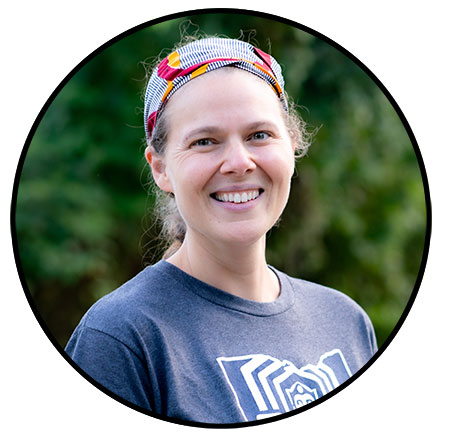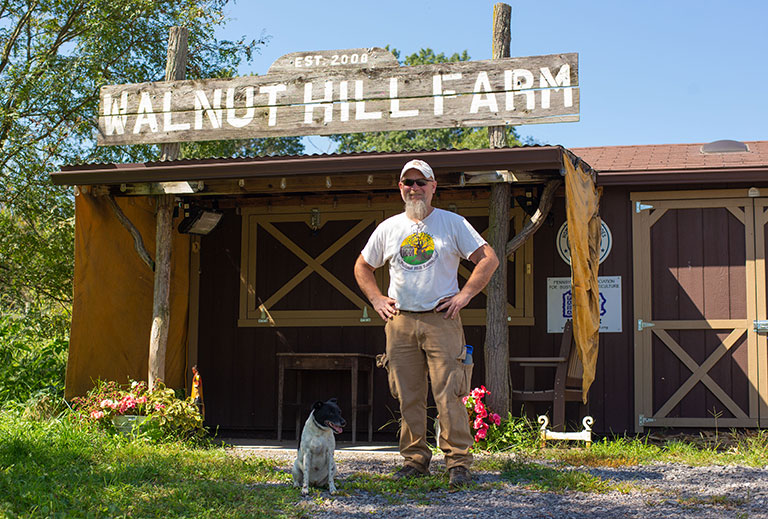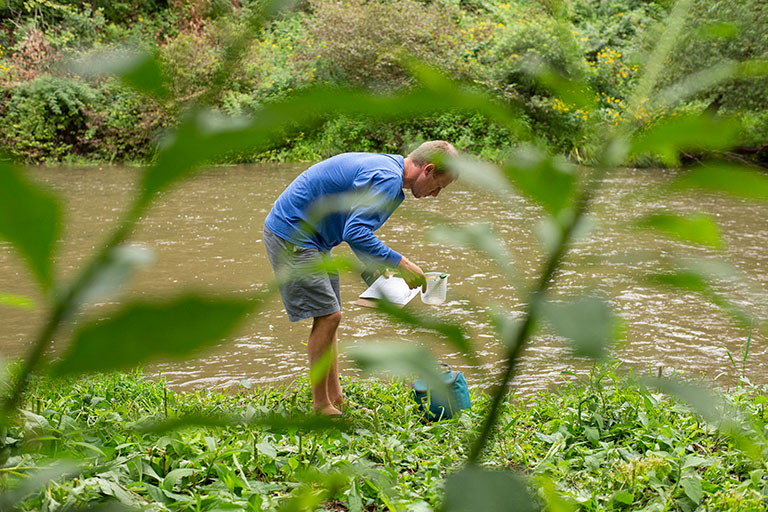In October of 2012, Pittsburgh native Tiffany Taulton was living in New York City as it was ravaged by Superstorm Sandy. Seawater surged over Lower Manhattan’s seawalls and highways, inundating tunnels, subway stations, and the electrical system that powers Wall Street. A large tanker ship ran aground on the city’s Staten Island. Over two days, relentless rain, wind, and water destroyed some 300 homes, left hundreds of thousands of people without power, and stranded many vulnerable New Yorkers with limited access to food, drinking water, and health care services.
“That was really when my life changed because I began to realize that climate change wasn’t a problem for 50 years from now,” says Taulton, who at the time was working in the public information office of the United Nations. “It wasn’t a problem for people somewhere else. It’s a problem for all of us, no matter where we live, and there’s no escaping it.”
With urgency, Taulton got to work, determined to be part of a solution. She trained in permaculture, a sustainable land management practice, and even became a doula, knowing that, during the storm, many pregnant women couldn’t make it to a hospital to give birth. Then she made a major life change: She moved to Pittsburgh to be closer to family after being away from the city for most of her life.
“When you have a disaster of such high magnitude like we had with Sandy, you can’t rely on government to help you at that point,” she says. “It’s really about your community, the people you know, and people taking care of each other.”
Today, Taulton is the director of outreach and sustainability for Hazelwood Initiative, a community development organization that works to balance commercial development with the needs of residents of one of Pittsburgh’s “sacrifice zones,” a neighborhood where community health was sacrificed for profit. In Hazelwood’s case, it was home to one of the region’s most productive steel mills, employing more than 5,000 workers during its heyday. Hazelwood Initiative is one of nine regional community changemakers spotlighted in We Are Nature: A New Natural History, Carnegie Museum of Natural History’s new museumwide experience that weaves fresh stories into existing displays to more clearly connect humans and the rest of nature.

“Hazelwood has been suffering a long economic decline. There’s an opportunity to ask, ‘What can we do here to bring it back and to bring it back in a way that is sustainable and climate-resilient?’”
-Tiffany Taulton, Director of Outreach and Sustainability for Hazelwood Initiative
“I thought, how much closer can you get to community and impacting their preparation for climate change than to work on community development?” says Taulton, who also teaches environmental justice at Duquesne University and is a member of Pittsburgh Mayor Ed Gainey’s transition committee on infrastructure and environment. “Hazelwood has been suffering a long economic decline. There’s an opportunity to ask, ‘What can we do here to bring it back and to bring it back in a way that is sustainable and climate-resilient?’”
Among Hazelwood Initiative’s priorities: Make the neighborhood more food-secure and reduce its carbon footprint by expanding its community gardens; plant trees and protect the 183 acres of greenway in the community, contributing to better air quality, the prevention of landslides, and curbing the urban heat island effect; incorporate community solar power to make its energy grid more resilient; and strengthen its partnerships with surrounding communities.
“When you’re looking to make a difference on climate change, it’s not just about your one community,” says Taulton. “It’s about the region as a whole.”

In the We Are Nature interactive gallery spaces at the Museum of Natural History, Taulton and the Hazelwood Initiative are featured among regional organizations who have a vision for a more positive climate future, with a focus on one of three areas: food and agriculture, outdoor recreation and green spaces, and energy and justice.
“We wanted to show visitors that other people care deeply about climate change, and that there are lots of ways to contribute and make a difference,” says Taiji Nelson, senior program manager for the museum’s Climate and Rural Systems Partnership (CRSP), a network of regional educators, scientists, and community leaders that fosters relationships and serves as a resource for rural communities coming to grips with the effects of climate change.
“Climate change is not just an ecological issue—it’s tied to jobs, the economy, our health,” Nelson notes. “It directly impacts people’s lives, and there is something you can do today, right here in our region, to fight it.”

“We wanted to show visitors that other people care deeply about climate change, and that there are lots of ways to contribute and make a difference.”
-Taiji Nelson, Senior Program Manager for the Climate and Rural Systems Partnership at Carnegie Museum of Natural History

Youth Naturalists at work as part of their Pittsburgh Parks Conservancy internship.
Putting Faith in Each Other
AJ Monsma, the community engagement coordinator at Garfield Community Farm, found her calling while in the Peace Corps in Rwanda, where she worked with kids living on the streets to build kitchen gardens.
The experience drew her to the farm, another community changemaker visitors will learn about in the We Are Nature experience. Garfield Community Farm began a decade ago as three acres of abandoned and degraded land, and today is one of Pittsburgh’s most productive urban farms. Part of its mission: to grow and learn about food and the earth, alongside its neighbors, particularly its youngest residents.
“The land was torn-down housing, and it was very desolate,” explains Monsma. “It was an intentional choice to show folks what can happen if you steward a place faithfully over the years. I love that that’s our beginning because that’s what we try and do with people, with land, with our relationship with food, with each other, and with the Earth—restore and heal.”

“We’re not here to just grow food and hand it out, we’re not here just to have fun events; we’re here for that healing and restoration in a very holistic way. Part of the faith side of it is just having this place where everyone feels safe no matter where they’re coming from.”
-AJ Monsma, Community Engagement Coordinator for Garfield Community Farm

AJ Monsma at work at Garfield Community Farm, one of Pittsburgh’s most productive urban farms.
The farm’s permaculture practice focuses on three core ethics: people care, Earth care, and “fair share,” says Monsma, which means equitably sharing its resources. “We’re not here to just grow food and hand it out, we’re not here just to have fun events; we’re here for that healing and restoration in a very holistic way. Part of the faith side of it is just having this place where everyone feels safe no matter where they’re coming from—whether that’s physically, mentally, spiritually. But they know they can be here and find sanctuary, whatever sanctuary means to them.”
Affiliated with the Open Door Presbyterian Church, the farm serves as a sustainable, organic produce source and community green space for local residents as well as a valuable educational tool about urban garden care, harvesting, and accessibility. It gets its produce into the hands of its neighbors in three key ways: a weekly farm stand, donations to a local food pantry, and a local community-supported agriculture (CSA) program.
“I think a lot of us saw that when COVID hit, the folks who seemed to be the most resilient were those who had strong relationships with a community that was local, and that will be the same with climate change,” says Monsma. “Your community will help you if you need a place to stay, if you need food. Caring for the Earth and for people is bound up together.”

Haddassa, a youth participant at Braddock Farms, which sits on the corner of Braddock and 10th Street against the backdrop of the borough’s last remaining steel mill.


Michael Kovach, who founded Walnut Hill Farm, strives to “raise the animals on our farm in as near to the fashion they were evolved to live, and let them eat in the ways they evolved to eat.”
Protect, Preserve, Restore
Among those regional organizations making a measurable difference in the climate fight are three groups that have been partnering with the museum for several years through its CRSP initiative: Western Pennsylvania Conservancy, Walnut Hill Farm in Mercer County, and the Mountain Watershed Association in the Laurel Highlands.
Ashley Funk, the executive director of the Mountain Watershed Association, grew up playing in an ash dump near her backyard and exploring the abandoned coke and coal mine operations nearby. As the seventh generation in her family to live in the Laurel Highlands, a mountainous region about an hour east of Pittsburgh, she was aware of the influence the coal industry—a major resource for Pittsburgh steel—had on her community.
As she got older, she started to recognize its environmental impacts, both on the local environment and on the climate. At 14, she organized litter pickups and recycling events. At 17, she joined efforts to file a lawsuit against the Commonwealth of Pennsylvania for failing to protect residents’ rights to a livable environment by not taking action to mitigate climate change.

Ashley Funk advocates for the protection of local watersheds as head of the Mountain Watershed Association.
Today, while mining is no longer the number-one industry in the area and the creeks no longer run orange, people in the community are still losing their homes and their drinking water to deep coal mines. Funk and the small staff of the community-based nonprofit are laser-focused on the protection, preservation, and restoration of the Indian Creek and greater Youghiogheny River watersheds.
“The majority of residents rely on well and spring water,” says Stacey Magda, a community organizer with the Mountain Watershed Association. “And if we lose that, what do we have? We wait the years and years and years and increased tax dollars to be tapped into municipal water, which we don’t want. If we don’t fight these impacts, what will be left of the people of the Laurel Highlands?”

“When communities come together, enormous things happen. Not only are we better connected to each other, but we get things done.”
-Stacey Magda, Community Organizer with the Mountain Watershed Association

From the remediation of abandoned mine discharges to advocating for increased stream protections and tighter regulations on shale gas development, the Mountain Watershed team promotes cooperative community efforts for stewardship and sound environmental management.
“When communities come together, enormous things happen,” says Magda, noting that volunteers are always needed. “Not only are we better connected to each other, but we get things done. So, remember— the independent things that you do on your own are real and respected. But take it the next level and get involved in your community to grow your efforts as a unit.”
There’s no doubt that Tiffany Taulton is thinking about the health of the entire Pittsburgh region, too. Having attended city planning meetings in New York post-Sandy, she heard a lot about “building back better.” But when she looked around rooms of 500 or so attendees, she saw only a handful of people who looked like her.
“Climate change is affecting communities of color, but communities of color are not in on the decisions about how we’re planning and preparing for climate change, how we’re mitigating and adapting, and it really got to me,” Taulton says, noting that it motivated her to join Hazelwood Initiative with boots on the ground. “I decided I was going to be that person to be involved and communicate to people who look like me and make sure they are part of these decisions.
“We have an opportunity to do something special, not just for Hazelwood but for the city as a whole—to invest in climate resistance, to invest in clean air for the city, to reduce asthma and flooding and landslides. As we saw with the terrible flooding in 2017 and 2018, Pittsburgh’s infrastructure is not ready, and the government budget is not ready to help that many people repair and save their homes from landslides. We need to prepare the tree cover for the entire city.”
There are many people and groups working in our region to transform human relationships with nature and build a more just future for everyone. To share their stories, Carnegie Museum of Natural History partnered with local documentarians Michael Pisano, David Kelley, Jamen Thurmond, and Di-ay Battad, who captured the images and quotes of community members for the We Are Nature exhibit.
This material is based upon work supported by the National Science Foundation under Grant No. 1906774. Any opinions, findings and conclusions or recommendations expressed in this material are those of the author(s) and do not necessarily reflect the views of the National Science Foundation.
Receive more stories in your email
Sign up
